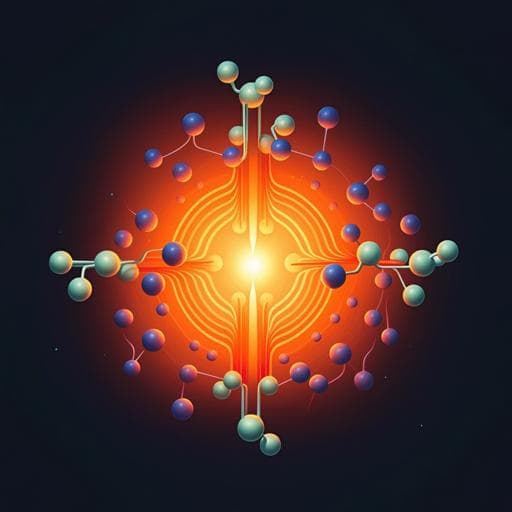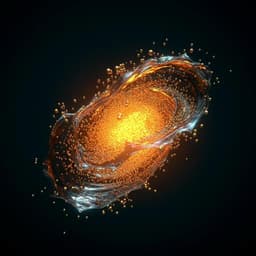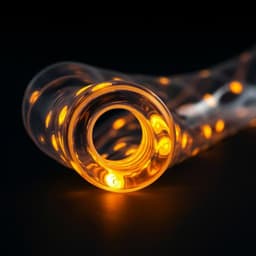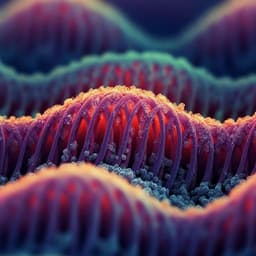
Chemistry
A new approach exploiting thermally activated delayed fluorescence molecules to optimize solar thermal energy storage
F. Meng, I. Chen, et al.
Discover the innovative world of thermally activated delayed fluorescence (TADF) molecules in solar thermal energy harvesting. This groundbreaking research by Fan-Yi Meng and colleagues identifies how molecular composites can convert solar energy into chemical energy and heat with remarkable efficiency and reversibility.
~3 min • Beginner • English
Introduction
The study addresses how to optimize solar thermal energy storage (MOST) using molecular systems that more effectively harvest visible light and store/release energy reversibly. The authors hypothesize that thermally activated delayed fluorescence (TADF) chromophores can serve simultaneously as photosensitizers, storage units, and signal transducers by enabling efficient triplet energy transfer to norbornadiene (NBD), triggering NBD → quadricyclane (QC) photoisomerization for storage, and allowing controlled QC → NBD back-conversion for heat release. By tuning the small S1–T1 gap and aligning the T1 energy of the TADF core relative to the NBD triplet (≈61 kcal/mol), they aim to maximize solar spectrum utilization and conversion efficiency while maintaining reversibility and durability.
Literature Review
The work builds on established NBD/QC MOST systems where QC → NBD back-reaction is highly exothermic and substituent-dependent. Prior reports indicate stepwise NBD → QC conversion when multiple NBD units are attached and that substituents influence reverse reaction kinetics and side reactions. The study leverages TADF principles, particularly small ΔEST enabling reverse intersystem crossing and triplet harvesting, to enhance visible-light utilization in MOST. Citations in the text note known QC → NBD enthalpies and previously observed mechanistic features for multi-NBD systems and substituent effects on reverse isomerization.
Methodology
- Molecular design and synthesis: Constructed TADF-based composites by anchoring NBD units to the PXZ-TRZ core, yielding PZDN (two NBDs), PZTN (four NBDs), and PZQN (alternative linker lowering T1 energy). Linker electronics and geometry were selected to tune LUMO and S1/T1 energies and donor–acceptor spacing for Dexter-type triplet–triplet energy transfer.
- Photophysical characterization: Recorded absorption and fluorescence at 298 K in cyclohexane; measured phosphorescence at 77 K in cyclohexane to estimate T1 energies from phosphorescence onset. Tracked TADF emission kinetics (time-resolved decay) in degassed cyclohexane under 405 nm excitation as a function of irradiation time to monitor quenching via triplet energy transfer to NBD.
- Dynamic simulation of kinetics: Employed a kinetic model with assumptions including millisecond T1 decay and using S1 population decay as proxy for prompt S1 decay. Extracted rate constants (triplet–triplet energy transfer KET, reverse intersystem crossing KRISC, and T1 radiative/nonradiative decay kp) from fits (Supplementary Table 1). Defined photoconversion efficiency Q.Y.eff via Eq. (1): Q.Y.eff = KET / (KET + KRISC + kp), and computed values for each composite.
- NMR monitoring of photoisomerization: Conducted 1H NMR in cyclohexane-d12 under 350–450 nm irradiation to observe disappearance of NBD signals and growth of QC signals for PZDN → PZDQC and PZTN → PZTQC. Assessed intermediates and conversion completeness by diagnostic peaks (e.g., NBD at ~5.1 ppm; QC at ~4.7–4.5 ppm and 1.2–1.7 ppm).
- Thermal reverse isomerization kinetics: For PZDQC, switched to toluene-d8 (bp 110.6 °C) and monitored QC → NBD at 348–368 K by 1H NMR to derive reverse rate constants krev. Constructed Arrhenius plot ln(krev) vs 1/T to extract Ea and Eyring plot ln(krev/T) vs 1/T to obtain ΔH‡ and ΔS‡. Attempted analogous measurements for PZTQC → PZTN at 95 °C; reaction found too slow for practical measurement.
- Catalyzed back-reaction: Tested CoTPP (cobalt tetraphenylporphyrin) as catalyst at room temperature in toluene-d8 for PZDQC and PZTQC; quantified regeneration of PZDN and PZTN by NMR peak growth.
- Durability/cycling: Monitored TADF emission intensity (~495 nm) in cyclohexane through multiple PZDN ↔ PZDQC cycles to assess fatigue resistance and reversibility, using emission quenching/restore as a convenient probe.
- Calorimetry: Performed DSC to quantify exothermic heat release upon QC → NBD. For PZDQC, integrated exotherm gave ΔH_storage of −161.8 kJ/mol (−280.0 J/g), consistent with two QC units reacting (literature ~−89 kJ/mol per QC). PZTQC showed only a weak exothermic signature, consistent with slower/back-reaction limitations and possible side processes.
Key Findings
- Energy alignment governs conversion: PZDN and PZTN have T1 onsets ≈63 kcal/mol (77 K), above the NBD triplet (~61 kcal/mol), making triplet energy transfer thermodynamically favorable; PZQN T1 onset ≈59 kcal/mol, rendering transfer to NBD unfavorable and drastically slowing NBD → QC.
- Photoconversion efficiencies (from kinetic simulations, Eq. 1): PZDN 59.4%; PZTN 14.3%; PZQN 3.7%.
- Dexter-type transfer efficiency correlates with donor–acceptor distance: Shorter PXZ-TRZ–NBD spacing in PZDN yields more efficient transfer than PZTN; PZQN’s transfer is thermally disfavored.
- Spectroscopic confirmation of photoisomerization: 1H NMR shows loss of NBD peaks (e.g., ~5.1 ppm) and growth of QC peaks (~4.7–4.5 ppm; 1.2–1.7 ppm) for PZDN → PZDQC and analogous changes for PZTN → PZTQC under 350–450 nm irradiation; no detectable one-QC intermediate for PZDN (likely short-lived).
- TADF behavior tracks conversion: For PZDN/PZTN, TADF emission quenches and decay dynamics change with irradiation time in degassed cyclohexane; PZQN shows negligible change even after >90 min irradiation, consistent with inefficient energy transfer.
- Thermal/catalytic back-reaction: PZDQC thermally reverts to PZDN with Arrhenius Ea = 23.59 ± 0.5 kcal/mol; Eyring parameters ΔH‡ = 97.14 ± 4.9 kJ/mol and ΔS‡ = −53 ± 2.1 J/mol in toluene-d8. CoTPP catalyzes QC → NBD at room temperature for both PZDQC and PZTQC, regenerating PZDN/PZTN quantitatively by NMR.
- Energy storage metrics (solution): PZDN ΔH_storage ≈ 162 kJ/mol (280 J/g) by DSC; PZDN QC half-life t1/2 ≈ 76 days (extrapolated to 298 K). For PZTN, reported ΔH_storage ≈ 7.97 kJ/mol (8.53 J/g). Fluorescence quantum yields (298 K, cyclohexane) vary with conditions; for PZDN values reported include 11.0%, 20.5%, 66.9% before/after irradiation under varying aeration.
- Durability: PZDN ↔ PZDQC exhibits excellent fatigue resistance over at least five cycles with consistent emission quenching/recovery and no unwanted emission observed during cycling.
Discussion
The findings validate the core hypothesis that TADF chromophores can optimize MOST by enabling efficient triplet energy transfer under visible excitation, provided their T1 energies are aligned just above the NBD triplet. PZDN and PZTN, with small ΔEST and T1 ≈ 63 kcal/mol, effectively sensitize NBD → QC, increasing the usable solar spectrum and allowing spectral monitoring via TADF quenching and dynamics. PZQN serves as a control demonstrating that if T1 lies below the NBD triplet, energy transfer becomes thermally unfavorable and photoconversion stalls. Dexter transfer efficiency further depends on donor–acceptor spacing, explaining the higher Q.Y.eff for PZDN relative to PZTN. The reversible QC → NBD reaction is feasible thermally (with characterized kinetics) and catalytically at room temperature (CoTPP), demonstrating practical heat release on demand. Calorimetry confirms substantial stored enthalpy consistent with QC stoichiometry. Durable cycling with minimal fatigue underscores the practicality of the TADF–NBD/QC design for MOST.
Conclusion
This work introduces a TADF-enabled MOST strategy wherein a single molecule integrates photosensitizer, storage unit, and transducer functions. By anchoring NBD to a PXZ-TRZ TADF core and tuning T1 slightly above the NBD triplet, the system achieves efficient visible-light-driven NBD → QC conversion (Q.Y.eff up to ~59%) and reversible QC → NBD heat release with strong durability. Spectroscopic, kinetic, and calorimetric data verify efficient energy transfer, substantial storage enthalpy, and robust cycling. Future directions include: precise control of linker electronics and geometry to fine-tune T1 near the NBD triplet threshold; optimizing donor–acceptor distances to maximize Dexter transfer; identifying catalysts enabling rapid, selective back-reaction at low temperature to suppress side pathways; and translating these molecular designs to condensed-phase/solid-state or device-integrated MOST platforms for practical solar thermal storage.
Limitations
- Energy-transfer inefficiency in PZQN due to T1 below the NBD triplet demonstrates a narrow energetic window for successful operation.
- For PZTN, the QC → NBD thermal back-reaction at 95 °C was too slow for practical kinetic measurements; slower reversal and more flexible sidechains may enable side reactions and reduce reversibility.
- Intermediates with only one QC formed during PZDN photolysis were not observed by 1H NMR, likely due to short lifetimes, limiting mechanistic resolution.
- Some measurements used different solvents (cyclohexane-d12 vs toluene-d8) for forward vs reverse reactions, which can shift NMR peaks and potentially influence kinetics.
- Reported calorimetry for PZTQC shows only weak exotherm, consistent with slow back-reaction and possible decomposition, constraining its practical utility relative to PZDN.
Related Publications
Explore these studies to deepen your understanding of the subject.







